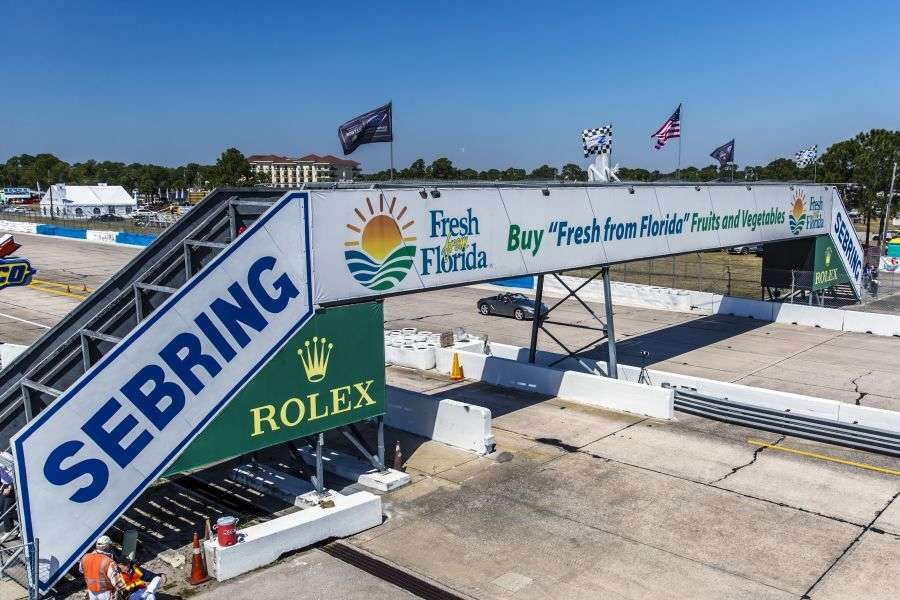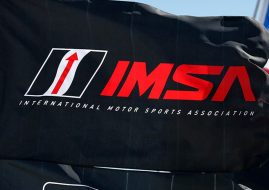Sebring International Raceway - Home of the Endurance Classic Since 1952
Sebring International Raceway is one of the oldest race tracks in the United States (opened in 1950) and the venue of the 12 Hours of Sebring, one of the world’s classic endurance races.
Except the famous 12-hour race, the circuit located near Sebring, Florida, is a testing facility for many teams during the winter due to a warm climate. Back in 1959, Sebring hosted its only Formula One Grand Prix race.
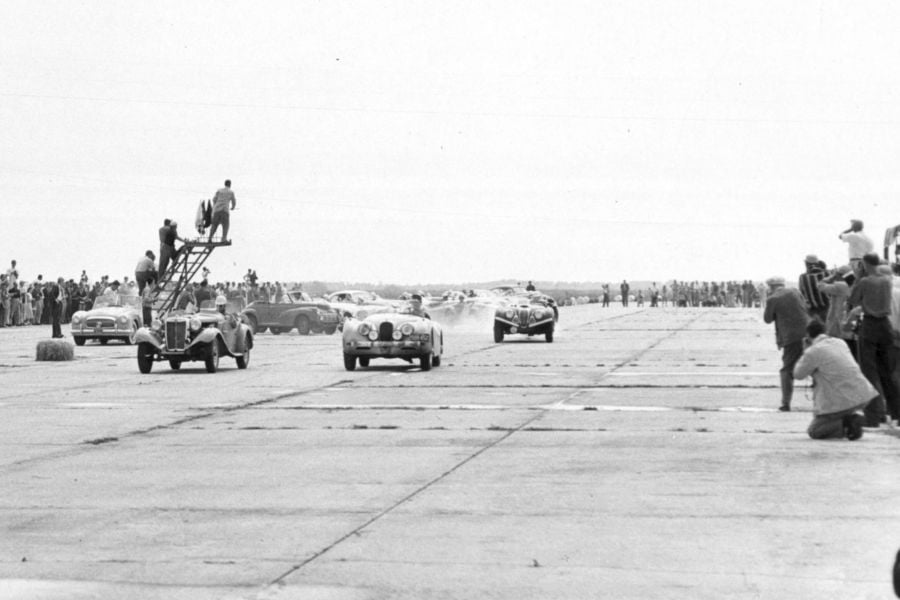
Start of the 1952 race, the first edition of 12 Hours of Sebring
The race track on the place of Air Force training base
The race track was built on the ground of the former US Army Air Forces training base, which was operative during the World War II. The site was called the Hendricks Field, in honor of a fallen flight instructor. After the war, the City of Sebring turned the airfield into the Sebring Air Terminal. Today, the current Sebring Regional Airport is still part of the raceway’s facility.
The first idea of racing on the airfield was born in the heads of racers Sam Collier and Bob Gegen in 1949, but the man who turned the idea into reality was an aeronautical engineer Alec Ulmann. He was seeking the site for his new business with the military aircraft refitted for the civilian use, but he was also impressed with the European style of racing which he saw at 24 hours of Le Mans race.
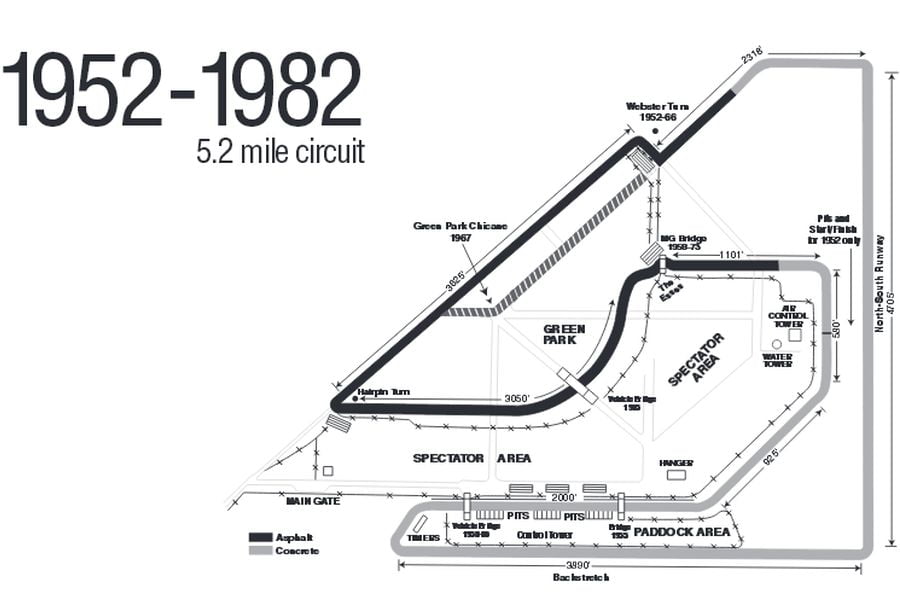
Map: First layout of the Sebring race track
Alec Ulmann brought the European style racing to America
Ulmann chose the former Hendricks Field and the first 3.5-mile race track was prepared during 1950, with two one-mile straights and twelve turns. The first race was held on New Year’s Eve of 1950. The race was named Sam Collier 6 Hour Memorial, in honor of a racer who died a few months earlier at Watkins Glen. The first winners were Fritz Koster and Ralph Deshon in the Crosley HotShot.
Fourteen months later, on March 15, 1952, the first 12 Hours of Sebring was held, as part of the AAA championship. The circuit was lengthened to 5.2 miles (8.36 km) and that layout was in the use since 1966.
12-hour race as part of the World Sportscar Championship
In 1953, the race became the part of the premium series, the World Sportscar Championship. The first WSC winners were Phil Walters and John Fitch with Briggs Cunningham’s C4R-Chrysler. In the next couple of years, many of the world’s famous drivers triumphed at Sebring, including Stirling Moss, Mike Hawthorn, Juan Manuel Fangio, Jean Behra, Peter Collins, Phil Hill, Dan Gurney, Olivier Gendebien, Jo Bonnier, and John Surtees, among others. Until 1966, the most successful manufacturer was Ferrari, with seven wins, while the driver with the most wins was Olivier Gendebien (3 wins).
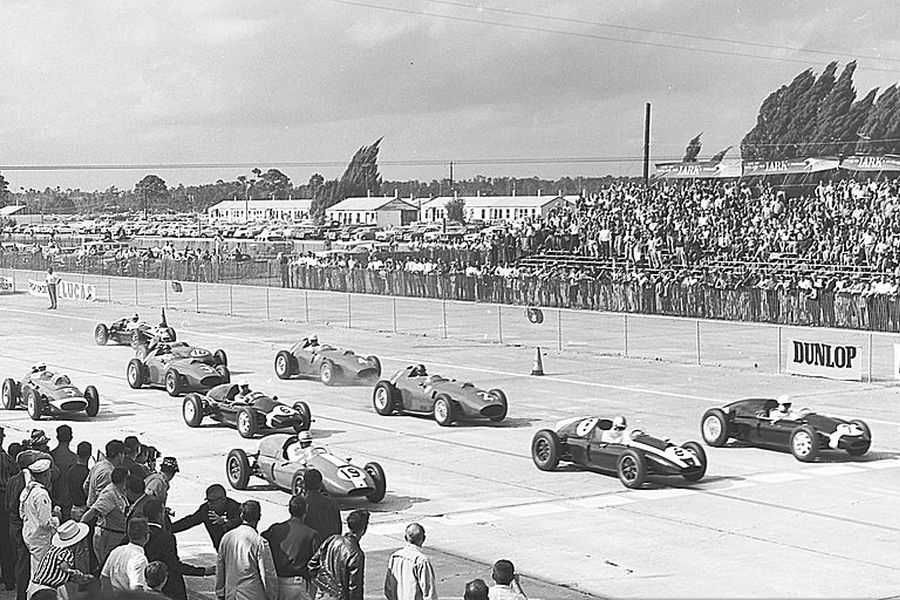
1959 Formula One United States Grand Prix at Sebring
Sebring hosted the 1959 F1 United States Grand Prix
The 5.2-mile layout was the venue of the only Formula One United States Grand Prix which was held at Sebring. It was in December of 1959. The race was originally scheduled for March 22, the day after the 12-hour race, but rescheduled for December 12, as the final round of the Formula One season and three months after the previous round at Monza.
There were seven American drivers on the starting grid of twenty drivers, and New Zealand’s Bruce McLaren scored his first F1 victory, just 0.6 seconds ahead of Maurice Trintignant. McLaren took the lead on the last lap of the race when his teammate Jack Brabham ran out of fuel. Brabham had to push his Cooper T51-Climax over the line to finish fourth and he won the drivers’ championship title. Despite an exciting climax to the season, the new location wasn’t popular and Formula One never returned to Sebring.

Le Mans-style start at Sebring
The tragedy struck Sebring International Raceway in 1966
The next milestone year in the Sebring’s history was 1966. Unfortunately, it was marked by tragedies during the 12-hour race. First, the Canadian Bob McLean was killed when his Ford GT40 rolled several times, struck a utility pole and then exploded. One more tragedy was to strike with two hours to go when Mario Andretti’s Ferrari slowed with gearbox trouble and it was hit by Don Wester’s Porsche. The Porsche went into a group of spectators, killing four of them.
During the pre-Le Mans battle of Ford GT40s against Ferraris, Ken Miles and Lloyd Ruby took the win in the #1 Shelby-American’s Ford GT40 X-1 Roadster. They won only because Dan Gurney, who was the leader until the last lap, stopped due to broken engine on his Ford GT40. He pushed the car over the finish line but he was later disqualified.
Improved safety
After the 1966 race, the circuit facilities and the safety were heavily criticized. There was even a plan to remove the endurance race to the new Palm Beach International Raceway. Bad weather conditions prevented the reconstruction of the Palm Beach race track, so it was decided that the 12-hour race would return to Sebring in 1967, but the safety must be improved.
The Warehouse Straight was moved further away from buildings, and a new chicane was added. It was also insisted that spectators must be kept at least 120 feet from the track, compared to the previous 75 feet. The length of the circuit remained 5.2 miles.
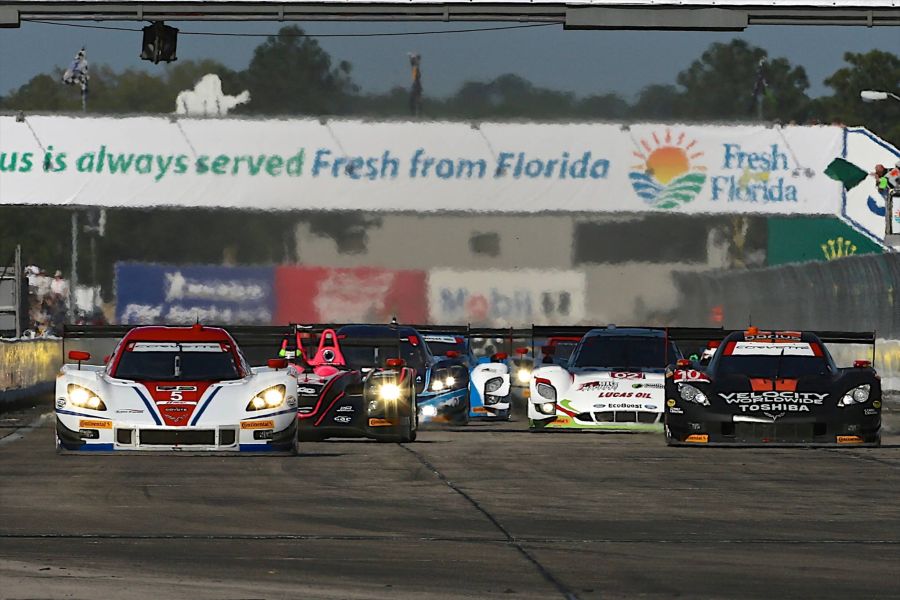
Florida’s main racing facility
Mario Andretti won three times at Sebring
Such track was used until 1982. In that period, the 12 Hours of Sebring was part of the International Championship for Makes and IMSA GT Championship. Mario Andretti was the most successful driver, with three wins between 1967 and 1972. In 1967, he won together with Bruce McLaren in the Ford GT40, so McLaren was the only driver who won F1 and sports car race at Sebring.
Some other world famous winners were Jo Siffert, Hans Herrmann, Jacky Ickx, Nino Vaccarella, Vic Elford, Hurley Haywood, Hans-Joachim Stuck, Allan Moffat, Brian Redman, and Al Hobert. Porsche dominated during that period with ten wins of the German manufacturer.
Many track changes at Sebring during 1980s and 1990s
In 1983, the track was changed and shortened to 4.75 miles, to allow simultaneous use of the track and one of the airplane runways. In 1987, some changes allowed the use of another runaway. The circuit was 4.11-mile long. Further changes in 1991 shortened the track to 3.7 miles (5.95 km), which was close to the current layout. The entire track could be used without interfering with the usual airport operations.
The last configuration of the circuit layout was made in 1999, with the final length of the Grand Prix Circuit being set to 3.74 miles. There was also a possibility to divide the 17-turn main circuit to two shorter tracks – Johnson Club Circuit and School Circuit. Some parts of the circuit still feature the original surface from the World War II airfield, so the track is renowned by its rough surface.
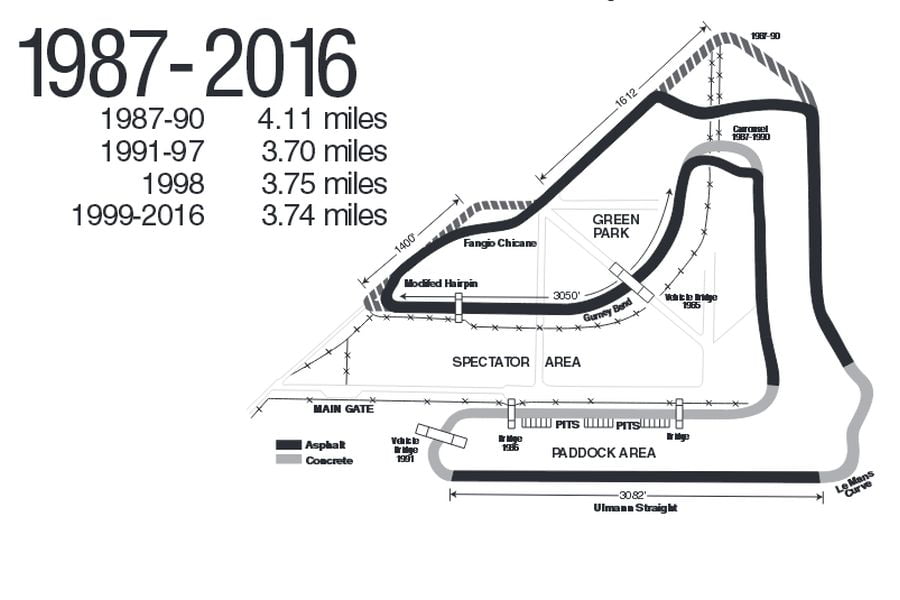
Map: Current Sebring track layout
The era of Tom Kristensen started in 1999
In 1999, the 12 Hours of Sebring became part of the American Le Mans Series and it was the year when the era of Tom Kristensen began. In 1999, he had won for the first time, sharing the BMW V12 LMR with JJ Lehto and Jorg Muller. In the next couple of years, Tom Kristensen won five more times with different Audi cars (last win in 2012) and became the absolute record-holder of Sebring with six wins.
Turns named in honour of racing greats
Nine-time Le Mans winner and six-time Sebring winner Tom Kristensen retired from racing in 2014. Two years later, in 2016, the Sebring International Raceway officially named Turn 3 as Kristensen Corner. The announcement of Kristensen Corner was made during Kristensen induction to the Sebring Hall of Fame. Kristensen was among six inductees into the Hall of Fame class 2016 and he became the first driver in over 20 years to have a turn named after him.
The Sebring circuit includes turns in honor of racing greats Briggs Cunningham, Sam Collier, Dan Gurney, Olivier Gendebien, Juan Manual Fangio, IMSA Founder John Bishop and Sebring race founder Alec Ulmann.
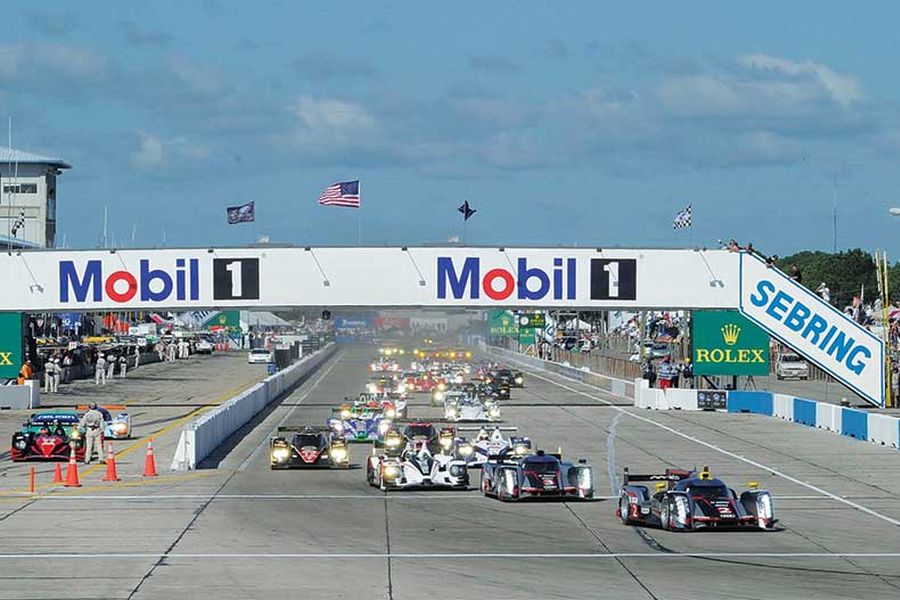
Sebring is the mecca of sports car racing since 1952
Ownership changes of the Sebring Raceway
During the 1990s and in the recent year, the Sebring International raceway underwent a few ownership changes. The Scandia Racing boss Andy Evas was the owner until 1997 when he sold the track to Don Panoz.
In 2012, the Panoz Motor Sports Group, including Sebring, was sold to NASCAR. The 12-hour race remained the main event, together with the Legends of Motorsport and Historic Sportscar Racing series. The raceway is also the home of the famous Skip Barber Racing School.
Video : Documentary – Sebring through the Decades
Address: Sebring International Raceway, 113 Midway Drive, Sebring, Florida 33870
Phone: +1 863 655-1442
Official website: sebringraceway.com
Photos: sebringraceway.com, gettyimages.com.


